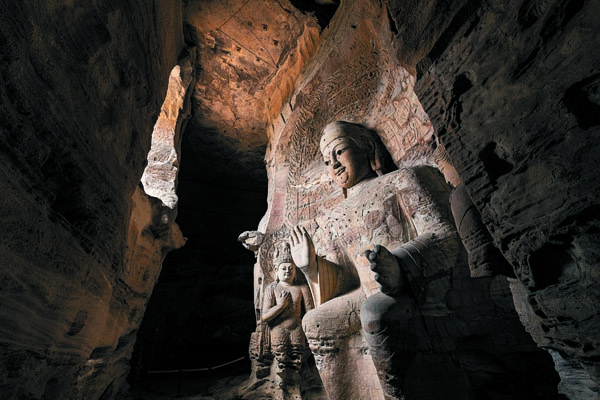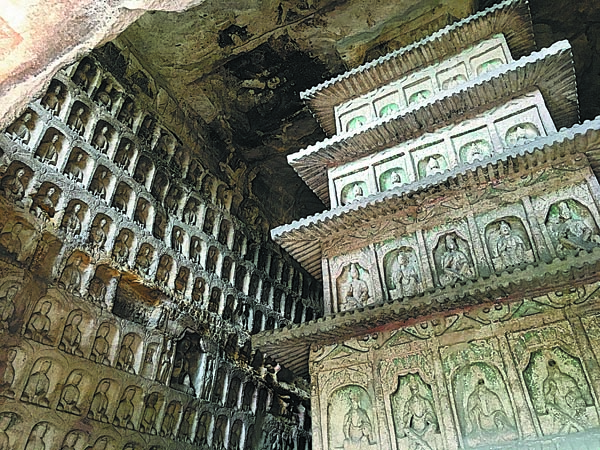Rock of ages

Cave 3 of the Yungang Grottoes features typical artistic elements from the early period of the Northern Wei Dynasty (386-534). [Photo provided to China Daily]
Ancient grotto temples show influences from far afield being utilized for Buddhist art, Lin Qi reports.
Editor's note: China is home to 56 UNESCO World Heritage sites. To find out how these natural and cultural gems still shine and continue to inspire the nation in this new era of development, China Daily is running a series of reports covering 10 groups of selected sites from across the country. In this installment, we retrace a history that's carved in the stone of the country's grotto temples.
Datong, in North China's Shanxi province, offers visitors a magnificent treat with special dances and music. Both have been performed for more than 1,500 years and utilize some of the oldest musical instruments from the East and the West.
And yet, it is mute and still. To truly enjoy it, one needs to make full use of their imagination.
This show to celebrate artistic diversity is staged inside the renowned Cave 12 of Yungang Grottoes, one of the most enthralling examples of Buddhist art in China.
With creativity and originality, artisans back as far as the late 5th century sculpted richly colored, highly decorative motifs in Yungang's dozens of grotto temples, hailing intensified cultural exchanges in Datong, then called Pingcheng, a thriving city along the ancient Silk Road.
This vibrant musical scene is described as "the fine voices of China "by Hang Kan, dean of the Yungang Research Institute in Datong and an archaeology professor at Peking University. He says it gathers the majority of instruments that were in use in countries along the Silk Road at the time.
Stretching along a south-facing cliff, Yungang is among the country's best-preserved Buddhist grotto temple complexes and a UNESCO World Heritage Site. Between the mid-5th and early 6th centuries, workers and artisans constructed dozens of cliffside caves and several hundred smaller niches. They then decorated those spaces with multicolored sculptures, patterns and architectural structures. Consequently, Yungang became an enduring legacy of history, art and culture.
Behind the construction of Yungang Grottoes was the patronage and auspices of the ruling family of the Northern Wei Dynasty (386-534). It hoped to showcase imperial superiority and to unite different ethnic clans living in its territory in northern China.
"What makes Yungang a unique case is that, you can see it as a 'state project', backed by Northern Wei's rulers and court elites," Hang says.

Cave 39 at the Yungang Grottoes. [Photo by Wang Kaihao/China Daily]
Each of the first five grotto temples houses a colossal Buddha statue, with a height of at least 13 meters, as the central icon for worship. They were built under the suggestion and supervision of Tanyao, a high-ranking monk cleric, and to commemorate Northern Wei's first five emperors.
"Thereafter this massive project utilized as many resources of the dynasty as possible, in a way to produce a 'state prototype', or the 'Yungang format'," Hang adds. "And it trained groups of skillful craftsmen who took with them the style of Yungang when moving to other parts of the country."
He says the influence of Yungang is evident in the representations of Buddhist art across the country, including the Longmen Grottoes in Luoyang, Henan province, which were built after the Northern Wei court relocated its capital city there from Pingcheng.
He says the model also shaped the styles of caves, statues and decorative motifs of grottoes created during the same period in Dunhuang, Gansu province.
Each of the caves in Yungang sparkles with creativity as a result of encounters, exchanges and infusions of artistic styles from the East and the West. The introduction of Buddhist art from Central and South Asia, which also presented a strong ancient Greek and Roman influence, was merged with Chinese cultural traditions that were already well-established before the arrival of Buddhism, and during the process artisans developed new styles and artistic traits to express the outlook on life and death of people at the time.
The variety of sculptures also increased to include Buddha in meditation or teaching doctrines. There are also feitian (the flying deities), jiyue (musicians and dancers), masculine warriors, monastics and Buddhist patrons.
More recent caves exhibited lavish patterns taken from the arts of different cultures, such as the dougong element of the interlocking wooden brackets in traditional Chinese architecture; the "Pompey Pillar" of ancient Rome; the mountain-shaped incense burners invented in China during the 3rd century BC, and the celestial chintamani praying stones for well-wishers from ancient India.
The statues' physical traits also underwent reforms. Buddhas made in Yungang's early phase have a broad forehead, high, sharply-cut noses and elongated eyes and eyebrows. The look produces a feeling of solemnity, delivering a message of power, boldness and confidence from Northern Wei, a dynasty founded by nomadic Xianbei people in northern China.
Buddhist statues from the later stages look slim, gentle and elegant. This aesthetic conformed with a gesture prompted by the dynasty's new emperors, to take on Han conventions and achieve ethnic unity.
Noted architect Liang Sicheng and his team investigated Yungang Grottoes in 1933. In an article about this survey, he concluded that the introduction of Buddhist art brought no fundamental changes to the basic structures of Chinese architecture, but inspired the creation of sculptural styles.
He said: "The spirit, the soul and the taste (of Yungang) are essentially Chinese. Meanwhile, it produced a great deal of novel motifs, patterns and methods of sculpting that spread and have been preserved until today, which is a phenomenon worthy of recognition."
